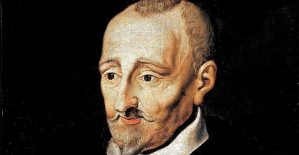You have to imagine Antwerp around 1600 as a wealthy trading city with a bourgeois flair. A potent group of buyers, a well-assorted network of art dealers operating throughout Europe brought a cultivated reputation. The leading role in European art production was undisputed until well into the 17th century.
A considerable contribution to the success can be attributed to the strictly regulated Guild of Saint Luke, whose members, the artists and art dealers of the city, benefited from optimized sales processes, the evaluation and testing of the respective artistic achievement. Keeping undesired competition in check was part of the protection and concept for the success of its members.
With the rapidly increasing demand, a workshop model developed that structured the production process. The master specified motif and composition, journeymen carried out. Finally, the master corrected and supplemented. The work was his creation, emerging from his workshop, endorsed by his signature.
The flourishing business with landscapes of high quality in terms of craftsmanship and composition, ultra-modern still lifes and innovative pictorial solutions led to a certain specialization of the painters. And this in turn leads to a cooperation between the otherwise independent artists. The guild didn't mind - as long as the lack of quality didn't ruin the reputation of the art metropolis.
What was usual for large projects, why shouldn't it also work on smaller ones? Peter Paul Rubens, the baroque painter prince, did it, Jan Brueghel the Elder did it and so did many others. The recipients of that time did not see these collaborations as patchwork, they liked the two-in-one variant, mainly with well-known protagonists.
A separation of the hands was (and is) often difficult. The Antwerp scene of mannerists and baroque painters was friendly, often also related to family. Attributions of individual works to different hands can best be secured if one can follow the logic of biographical records.
Joos de Momper the Younger, a gifted landscape painter, often left the design of his Arcadian mountain and cave impressions with finely painted lively groups of figures to his friend Jan Brueghel the Younger. The two were well versed in these joint works.
The wintry urban landscape, which the Koller auction house in Zurich appraises at 100,000 Swiss francs in the old master auction on September 23, appears to be cast in one piece, explains expert Klaus Ertz. He places the 74 by 106 centimeter picture in the period around 1630 and secures the history of its origin for the first time.
The previous Swiss and Belgian owners were not aware of this. You probably liked the characteristic motif, the fine lighting and the lively staffage. "Wintertjes" were among the favorite motifs of de Momper. He did not create all of them in this size, he is known for the smaller format anyway.
A small hilly coastal landscape with fish sellers, composed around the same time with Jan Brueghel the Younger and now also attributed by Ertz as a joint work, is estimated by Koller at 40,000 francs.

 United States: divided on the question of presidential immunity, the Supreme Court offers respite to Trump
United States: divided on the question of presidential immunity, the Supreme Court offers respite to Trump Maurizio Molinari: “the Scurati affair, a European injury”
Maurizio Molinari: “the Scurati affair, a European injury” Hamas-Israel war: US begins construction of pier in Gaza
Hamas-Israel war: US begins construction of pier in Gaza Israel prepares to attack Rafah
Israel prepares to attack Rafah First three cases of “native” cholera confirmed in Mayotte
First three cases of “native” cholera confirmed in Mayotte Meningitis: compulsory vaccination for babies will be extended in 2025
Meningitis: compulsory vaccination for babies will be extended in 2025 Spain is the country in the European Union with the most overqualified workers for their jobs
Spain is the country in the European Union with the most overqualified workers for their jobs Parvovirus alert, the “fifth disease” of children which has already caused the death of five babies in 2024
Parvovirus alert, the “fifth disease” of children which has already caused the death of five babies in 2024 Falling wings of the Moulin Rouge: who will pay for the repairs?
Falling wings of the Moulin Rouge: who will pay for the repairs? “You don’t sell a company like that”: Roland Lescure “annoyed” by the prospect of a sale of Biogaran
“You don’t sell a company like that”: Roland Lescure “annoyed” by the prospect of a sale of Biogaran Insults, threats of suicide, violence... Attacks by France Travail agents will continue to soar in 2023
Insults, threats of suicide, violence... Attacks by France Travail agents will continue to soar in 2023 TotalEnergies boss plans primary listing in New York
TotalEnergies boss plans primary listing in New York La Pléiade arrives... in Pléiade
La Pléiade arrives... in Pléiade In Japan, an animation studio bets on its creators suffering from autism spectrum disorders
In Japan, an animation studio bets on its creators suffering from autism spectrum disorders Terry Gilliam, hero of the Annecy Festival, with Vice-Versa 2 and Garfield
Terry Gilliam, hero of the Annecy Festival, with Vice-Versa 2 and Garfield François Hollande, Stéphane Bern and Amélie Nothomb, heroes of one evening on the beach of the Cannes Film Festival
François Hollande, Stéphane Bern and Amélie Nothomb, heroes of one evening on the beach of the Cannes Film Festival Skoda Kodiaq 2024: a 'beast' plug-in hybrid SUV
Skoda Kodiaq 2024: a 'beast' plug-in hybrid SUV Tesla launches a new Model Y with 600 km of autonomy at a "more accessible price"
Tesla launches a new Model Y with 600 km of autonomy at a "more accessible price" The 10 best-selling cars in March 2024 in Spain: sales fall due to Easter
The 10 best-selling cars in March 2024 in Spain: sales fall due to Easter A private jet company buys more than 100 flying cars
A private jet company buys more than 100 flying cars This is how housing prices have changed in Spain in the last decade
This is how housing prices have changed in Spain in the last decade The home mortgage firm drops 10% in January and interest soars to 3.46%
The home mortgage firm drops 10% in January and interest soars to 3.46% The jewel of the Rocío de Nagüeles urbanization: a dream villa in Marbella
The jewel of the Rocío de Nagüeles urbanization: a dream villa in Marbella Rental prices grow by 7.3% in February: where does it go up and where does it go down?
Rental prices grow by 7.3% in February: where does it go up and where does it go down? Even on a mission for NATO, the Charles-de-Gaulle remains under French control, Lecornu responds to Mélenchon
Even on a mission for NATO, the Charles-de-Gaulle remains under French control, Lecornu responds to Mélenchon “Deadly Europe”, “economic decline”, immigration… What to remember from Emmanuel Macron’s speech at the Sorbonne
“Deadly Europe”, “economic decline”, immigration… What to remember from Emmanuel Macron’s speech at the Sorbonne Sale of Biogaran: The Republicans write to Emmanuel Macron
Sale of Biogaran: The Republicans write to Emmanuel Macron Europeans: “All those who claim that we don’t need Europe are liars”, criticizes Bayrou
Europeans: “All those who claim that we don’t need Europe are liars”, criticizes Bayrou These French cities that will boycott the World Cup in Qatar
These French cities that will boycott the World Cup in Qatar Medicine, family of athletes, New Zealand…, discovering Manae Feleu, the captain of the Bleues
Medicine, family of athletes, New Zealand…, discovering Manae Feleu, the captain of the Bleues Football: OM wants to extend Leonardo Balerdi
Football: OM wants to extend Leonardo Balerdi Six Nations F: France-England shatters the attendance record for women’s rugby in France
Six Nations F: France-England shatters the attendance record for women’s rugby in France Judo: eliminated in the 2nd round of the European Championships, Alpha Djalo in full doubt
Judo: eliminated in the 2nd round of the European Championships, Alpha Djalo in full doubt


















